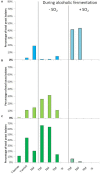Persistence of Two Non-Saccharomyces Yeasts (Hanseniaspora and Starmerella) in the Cellar
- PMID: 27014199
- PMCID: PMC4779898
- DOI: 10.3389/fmicb.2016.00268
Persistence of Two Non-Saccharomyces Yeasts (Hanseniaspora and Starmerella) in the Cellar
Abstract
Different genera and/or species of yeasts present on grape berries, in musts and wines are widely described. Nevertheless, the community of non-Saccharomyces yeasts present in the cellar is still given little attention. Thus it is not known if the cellar is a real ecological niche for these yeasts or if it is merely a transient habitat for populations brought in by grape berries during the winemaking period. This study focused on three species of non-Saccharomyces yeasts commonly encountered during vinification: Starmerella bacillaris (synonymy with Candida zemplinina), Hanseniaspora guilliermondii and Hanseniaspora uvarum. More than 1200 isolates were identified at the strain level by FT-IR spectroscopy (207 different FTIR strain pattern). Only a small proportion of non-Saccharomyces yeasts present in musts came directly from grape berries for the three species studied. Some strains were found in the must in two consecutive years and some of them were also found in the cellar environment before the arrival of the harvest of second vintage. This study demonstrates for the first time the persistence of non-Saccharomyces yeast strains from year to year in the cellar. Sulfur dioxide can affect yeast populations in the must and therefore their persistence in the cellar environment.
Keywords: Hanseniaspora; Starmerella; cellar; non-Saccharomyces strains; persistence.
Figures

 ) and with SO2 (
) and with SO2 ( ) for 2012 vintage. These percentages correspond to yeast belonging to the respective species compared to the total number of yeast isolates in the corresponding sample time.
) for 2012 vintage. These percentages correspond to yeast belonging to the respective species compared to the total number of yeast isolates in the corresponding sample time.


Similar articles
-
Effects of High Sugar Content on Fermentation Dynamics and Some Metabolites of Wine-Related Yeast Species Saccharomyces cerevisiae, S. uvarum and Starmerella bacillaris.Food Technol Biotechnol. 2020 Mar;58(1):76-83. doi: 10.17113/ftb.58.01.20.6461. Food Technol Biotechnol. 2020. PMID: 32684791 Free PMC article.
-
Diversity of yeast strains of the genus Hanseniaspora in the winery environment: What is their involvement in grape must fermentation?Food Microbiol. 2015 Sep;50:70-7. doi: 10.1016/j.fm.2015.03.009. Epub 2015 Apr 3. Food Microbiol. 2015. PMID: 25998817
-
FT-IR spectroscopy: A powerful tool for studying the inter- and intraspecific biodiversity of cultivable non-Saccharomyces yeasts isolated from grape must.J Microbiol Methods. 2016 Feb;121:50-8. doi: 10.1016/j.mimet.2015.12.009. Epub 2015 Dec 12. J Microbiol Methods. 2016. PMID: 26688103
-
From the vineyard to the cellar: new insights of Starmerella bacillaris (synonym Candida zemplinina) technological properties and genomic perspective.Appl Microbiol Biotechnol. 2021 Jan;105(2):493-501. doi: 10.1007/s00253-020-11041-9. Epub 2021 Jan 4. Appl Microbiol Biotechnol. 2021. PMID: 33394145 Review.
-
Not your ordinary yeast: non-Saccharomyces yeasts in wine production uncovered.FEMS Yeast Res. 2014 Mar;14(2):215-37. doi: 10.1111/1567-1364.12111. Epub 2013 Nov 11. FEMS Yeast Res. 2014. PMID: 24164726 Review.
Cited by
-
Genome sequence of the non-conventional wine yeast Hanseniaspora guilliermondii UTAD222 unveils relevant traits of this species and of the Hanseniaspora genus in the context of wine fermentation.DNA Res. 2019 Feb 1;26(1):67-83. doi: 10.1093/dnares/dsy039. DNA Res. 2019. PMID: 30462193 Free PMC article.
-
Grape-associated fungal community patterns persist from berry to wine on a fine geographical scale.FEMS Yeast Res. 2023 Jan 4;23:foac067. doi: 10.1093/femsyr/foac067. FEMS Yeast Res. 2023. PMID: 36592956 Free PMC article.
-
New Insights into the Oenological Significance of Candida zemplinina: Impact of Selected Autochthonous Strains on the Volatile Profile of Apulian Wines.Microorganisms. 2020 Apr 26;8(5):628. doi: 10.3390/microorganisms8050628. Microorganisms. 2020. PMID: 32357569 Free PMC article.
-
Wine Yeast Terroir: Separating the Wheat from the Chaff-for an Open Debate.Microorganisms. 2020 May 25;8(5):787. doi: 10.3390/microorganisms8050787. Microorganisms. 2020. PMID: 32466171 Free PMC article.
-
Genome Sequencing and Comparative Analysis of Three Hanseniaspora uvarum Indigenous Wine Strains Reveal Remarkable Biotechnological Potential.Front Microbiol. 2020 Jan 21;10:3133. doi: 10.3389/fmicb.2019.03133. eCollection 2019. Front Microbiol. 2020. PMID: 32038567 Free PMC article.
References
-
- Albertin W., Miot-Sertier C., Bely M., Marullo P., Coulon J., Moine V., et al. (2014). Oenological prefermentation practices strongly impact yeast population dynamics and alcoholic fermentation kinetics in Chardonnay grape must. Int. J. Food Microbiol. 178 87–97. 10.1016/j.ijfoodmicro.2014.03.009 - DOI - PubMed
LinkOut - more resources
Full Text Sources
Other Literature Sources

